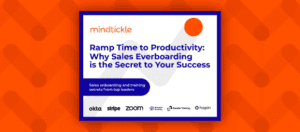There’s no denying that a good sales onboarding program is vital for new reps. A well-developed program will not only provide sales professionals with information about the products they’ll be selling, and the prospects they’re pitching. It will also equip them with the right questions to ask, and the likely objections they’ll face. Reps will understand the market and the best ways to deal with situations that may arise during the course of a prospect engagement. Onboarding is the foundation for success.
Onboarding is just the beginning, but too many teams stop there, neglecting the next step: sales everboarding.
If the goal of sales enablement is to equip sellers with the ability to sell, then it can’t stop at onboarding.
Every time a seller goes out into the field or picks up the phone to make a pitch, they face a fundamental problem: Which tools in my sales toolbox will help me close this particular client?
What sales enablement leaders are saying about onboarding
In today’s world, the modern seller has so many tools to use that they can struggle to pick the right one. Nick Salas, Head of Sales Readiness at Mindtickle, calls it the “moment of truth.” The point of sales enablement is to help sellers recognize that moment and prepare them with the tools to best respond to close the deal.
Salas sees two keys to closing. Sellers need to connect with the buyer, and communicate a value proposition that resonates and solves the buyer’s problem.
But they also need to handle the prospect’s objections and questions about competitors — and that requires quick-thinking and a good handle on the products and services they’re selling.
“Every second they’re in front of a prospect, they’re juggling a whole lot of stuff in their brain, and it can be hard to keep track,” says Salas.
Whether they’re newbies or veterans, sellers face these challenges every day of their careers. No matter how experienced they are, there is always a new product, new competitor, or new market change around the corner.
If these are the challenges for individual sellers, imagine how this problem multiplies for revenue leaders who may have hundreds or thousands of sellers to train, support, and keep productive.
This is why genuine sales readiness needs to be a continual process of learning, reinforcing knowledge, changing behaviors, and ongoing preparation.
“When that moment of truth comes, the rep is confident and ready,” says Salas.
Constantly equipping reps to succeed
Rehan Chishty, Enablement Platforms Manager at Okta, believes that the idea of sales readiness is to be constantly helping reps succeed in their current role, and prepare them with what they need to get to the next level — whether that be as a manager, an account executive, or whatever their career goals are. Chishty says with that in mind, onboarding is a good start, but it’s a bad place to stop.
Similarly, Damon Jones, Head of Global Strategy & Growth at Sandler Training, says sales enablement training needs to be delivered continuously to drive long-term success. For Jones, the best enablement programs incorporate repetitive activities designed to develop, test, and improve seller behaviors. At Sandler, he makes sure training modules speak directly to real-world interactions because sales enablement is about understanding the behaviors, techniques, and knowledge required to be ready to sell, no matter the situation.
“Sales reps learn what’s directly applicable to the job they’ll do out in the field — otherwise, why are we teaching them?” Jones says.
When it comes to working with reps, Michelle Dotson, Head of Sales Enablement at Zoom, starts with setting goals and then measuring their success over time. That means going beyond onboarding, because goals simply aren’t relevant unless they’re personal, actionable, and followed up on over time. Expectations need to be transparent and attainable, so she makes sure to give clear expectations from the start. But it doesn’t stop there.
“Telling someone about a goal once won’t help them achieve it,” says Dotson. “Training needs to be reinforced to be successful.”
Sales enablement requires understanding how to make reps successful
Gopkiran Rao, Chief Strategy Officer at Mindtickle, says the best sales everboarding comes from having a true understanding of what it means to be a successful salesperson and building training around those qualities.
“For any given role, start by interviewing top performers. Look at the patterns of what they do at every stage of a winning customer engagement,” says Rao.
He says sales excellence starts with a basic premise: Don’t rely on assumptions. Prepare, test, train, and repeat.
Sales enablement training can’t be a one-off, and it can’t be done on the fly. Sales leaders need to break down what reps need to know into discrete learning outcomes, then develop an ongoing curriculum to teach, test, and reinforce those outcomes over the course of the rep’s career. These learning outcomes need to be understood in terms of what a rep needs to exhibit and accomplish. And it’s important to remember that everyone learns differently, so managers must provide varied ways to learn the same thing.
For Mindtickle’s Salas, sales readiness starts even before the rep starts their first day. It’s about collecting as much data as possible to understand a sales rep’s individual training needs, and developing a long-term program for them. In fact, sales enablement data is the most valuable tool for sales excellence, says Salas. It not only helps everyone understand the progress of individual reps, but it also helps managers determine what areas of their training program require the most attention across the board.
How does your team compare to these best practices? Help your sellers be the best sales professionals they can be by using continuous learning and data driven sales enablement to be ready for anything.
When that moment of truth comes, will your team be ready to meet it? To learn more from these leaders, download our eBook, “Ramp Time to Productivity: Why Sales Everboarding is the Secret to Your Success.”




 By Helen Waite
By Helen Waite

 By Rahul Mathew
By Rahul Mathew